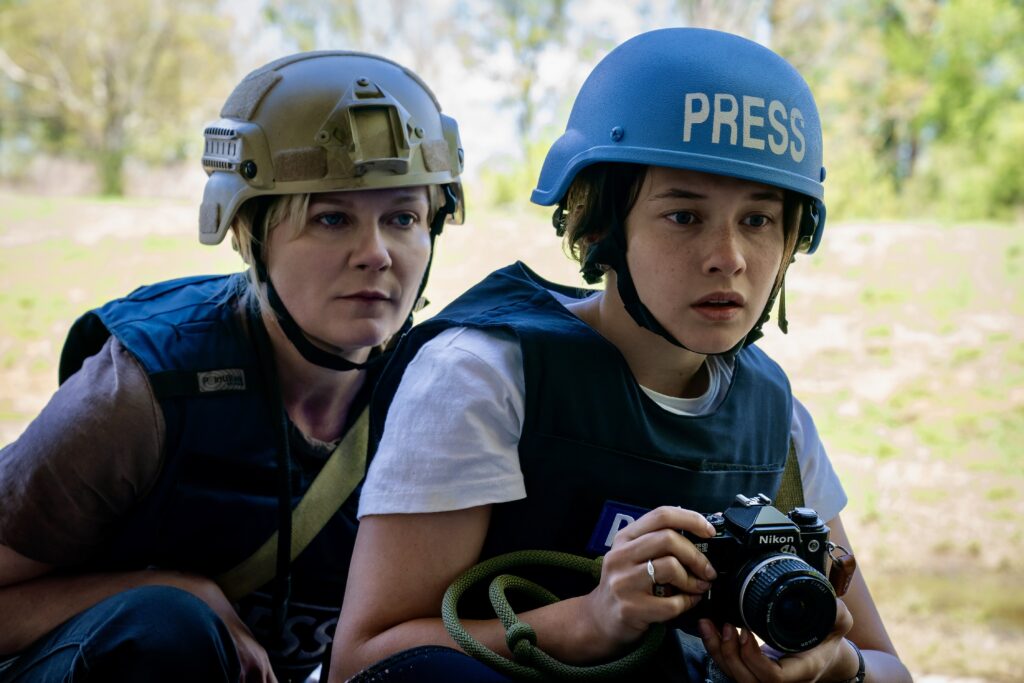
(**)
It’s like someone set a house on fire, then hid behind a bush to see what the crowd’s reaction would be.
28 Days Later was a shocking and terrifying zombie film. Credit director Danny Boyle and actors Cillian Murphy and Naomie Harris for putting pure fright in that nightmarish, post-apocalyptic tale. But the real kudos must go to screenwriter Alex Garland for the premise, execution and climax of a very thrilling movie. As a director Garland is most known for the sci-fi/thriller Ex Machina. His latest project, Civil War, takes him back to his “world is going to hell in a hand basket” roots. It’s a well he’s gone to too many times.
America is in turmoil and complete chaos. Texas and California and other states have seceded. (Does that make sense? Is this to avoid throwing just the southern states under the bus? History books note that that region seceded from the union. Newspapers note that some of those states still threaten to do so, today. Is this kind of political haziness meant to make the film feel like it isn’t taking sides? If so, it’s one of the film’s weak points—but there are others.
Word is out that the White House and its president will soon be under siege, as rebel factions head to DC to put the Commander in Chief’s (Nick Offerman) head on a chopping block. (Think Marie Antoinette, France and the guillotine).
The press hangs out in a hotel, as they’re known to do, contemplating next steps. Lee (Kirsten Dunst), an acclaimed war photographer, wants that big photo of the president in his final hours, real bad. Joel (Wagner Moura), an investigative reporter, wants his last interview. Danger is in the cards: “They shoot journalists on sight at the capital.”
As they mull over tactics, travel routes and goals, the older intrepid reporter Sammy (Stephen McKinley Henderson) chimes in. A young photojournalist wanna be, Jessie (Cailee Spaeny), worms herself into the quartet. Lee chides the novice: “There isn’t any version of this that isn’t a mistake.” The plan? Head to the nation’s capital in a bright white SUV with the word “Press” plastered on the side. Try to avoid being shot by militias along the way. Survive impending mayhem, crossfires and bombs to get that career-defining story.
Not a bad setup. Road trips have a natural momentum. This excursion does too. Watching the battle scenes, skirmishes with police, snipers on roofs and urban combat is intriguing. The action is broken up with black and white photos of the conflict. Like you’re seeing what the photographer sees, shoots and will print. Initially it’s an alluring device. As the film progresses, this ploy wears thin. Though it’s not nearly as frustrating as the script’s characters.
Lee, a respected veteran, is on a mission to expose the truth. The war, terror and upheaval Americans see on TV in other countries is now taking place in the U.S., propagated by citizens. Not the “those people.” This time it’s the “us people.” The very lascivious Joel invites a young woman, who has the looks and maturity of a highschooler, on a very dangerous trip for ulterior motives. The second he hits on her; his character becomes a repulsive lech. Jessie is ambitious, reckless and so callous to Lee, her ultimate protector, it’s easy to dislike her. In fact, for most of them a vulture-like vibe overpowers any altruistic notions. It’s an alienating, miscalculation that lingers.
The script and direction, like in the old days when filmmakers didn’t know any better, kill of the POC characters, first. Tony (Nelson Lee) and Bohai (Evan Lai), two carefree Asian journalists, are added to the caravan. In a particularly repulsive and excessive scene, the whole group encounters white racist nationalists who’re led by one devil (Jesse Plemons) who has a specific grudge. He asks them, “What kind of American are you?” He’s also interested in where they’re from. Jessie, “Missouri.” Lee, “Colorado.” Tony, “Hong Kong.” The fiend shoots Tony in the chest point blank, just for cheesy shock value. This kind of excess, in an already incendiary film, verifies that the filmmakers have lost their way.
The time in between the skirmishes is dull. The characters aren’t that interesting. Their relationship dynamics shallow and weak. The more you get to know them, the more likely you are to feel that they’re no more than cunning ambulance chasers. Clearly, as a writer/director and thinker, Garland is better with movement, predicaments, fight scenes, violence and shock than he is with viable drama. His screenplay and direction try to be profound, but have the depth of a zombie movie, without the zombies.
The sets (production designer Caty Maxey), costumes (Meghan Kasperlik) and cinematography (Rob Hardy) are not in question. The editing (Jake Roberts) is judicious with action scenes, not with what’s in-between. The musical score (Geoff Barrow and Ben Salisbury) and playlist are sometimes galvanizing. Sometimes completely counterintuitive.
Dunst wears her emotions on her face. She underplays her character perfectly and does the best she can with what’s on the page. However, Rosamund Pike, as New York Times war journalist Marie Colvin in Private War, had greater material, played a better developed character and left a more indelible impression. Henderson, and any mob he can gather, should forcefully ask the writer/director why he killed Sammy him off so soon. Lee and Lai display the right amount of friskiness and horror. Moura and Spaeny’s performances, as despicable characters, aren’t impressive.
This hollow, dystopian nightmare ends after 1h 49m. Its ten-minute finale is far more interesting than the 1h 39m that precedes it. Which has the shallow depth of generic films like White House Down or Netflix’s gloomy Leave the War Behind. Nothing deeper.
When the fire created by Civil War goes out, it’s easy to feel you’ve been manipulated. Like a house was burned down to the ground just to provoke a reaction. Nothing more.
Trailer: https://www.youtube.com/watch?v=aDyQxtg0V2w
Visit Film Critic Dwight Brown at DwightBrownInk.com.